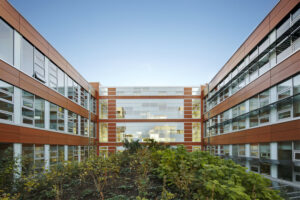This is more than just a building; it’s a research tool that demonstrates the power of sustainable design and serves as a catalyst for change
Located on a dense site at the University of British Columbia (UBC) in Vancouver, Canada, The Centre for Interactive Research on Sustainability (CIRS) hosts researchers from private, public, and non-government organisation sectors, who collaborate to produce innovations in sustainable tech and building practices. The 5675 sqm, $23 million (CAD) building sits just west of the campus’s Main Mall, edging a new landscaped “Sustainability Street” cross-axis and features offices for academic departments committed to the study of sustainability principles in the built environment
The CIRS is a globally renowned research institution with a mission to advance the adoption of sustainable building and urban development practices. CIRS is a state-of-the-art “living-lab”, where scientists from leading academic institutions conduct interactive research on current and future building systems and technologies. Partners from private and public sectors share the facility, making sure that the research is linked to real and practical world needs.
The building maximises passive environmental strategies and demand reduction, showcases sustainable systems and achieves net-positive energy, net-zero water and net-zero carbon in both construction and operations. CIRS is a ‘regenerative’ building, meaning it seeks not just to minimise environmental impacts, but also improve both the environment and lives of its users. Exceeding LEED Platinum status, CIRS was designed to be ‘net positive’ in seven different ways: energy, structural carbon, operational carbon, water, turning passive occupants into active inhabitants, promoting wellbeing and productivity and promoting happiness
This ‘living building’ collects sunlight and captures waste heat from a nearby building, all while exchanging heating and cooling with the ground – returning 600-megawatt-hours of surplus energy back to campus, while removing 170 tonnes of GHG emissions annually. Designed to supply 100% of the facility’s water demand, CIRS gathers rainwater for potable use and purifies wastewater in an on-site solar aquatics biofiltration. CIRS’s wood structure furthermore holds 904 tonnes of carbon, reducing the carbon footprint compared to the average UBC building by about 90%.
These #buildingheroes are leading real estate into the future! The University of British Columbia Perkins&Will Fast + Epp Stantec Heatherbrae Builders UBC Properties Trust PWL Partnership Landscape Architects Inc. NovaTec Consultants Inc. ECO-TEK Ecological Technologies Inc Morrison Hershfield BKL Consultants LMDG Building Code Consultants Ltd. Western Archrib
#sustainability #greenbuildings #climatechange #sustainablerealestate #netzerocarbon




